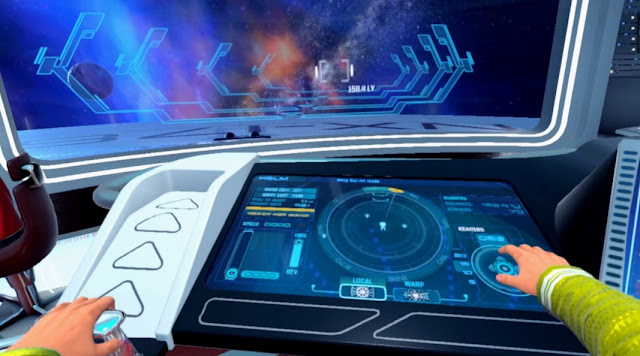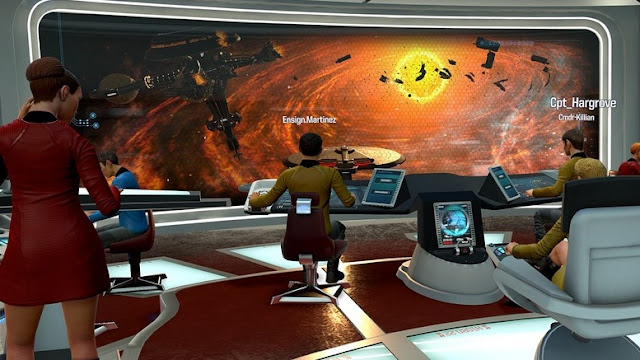Review by Matt S.
As someone who doesn’t really like doing the online multiplayer thing – particularly with narrative and atmosphere-heavy experiences (people just can’t commit to the roleplay, damnit), I say this: Star Trek: Bridge Crew is utterly brilliant. Ubisoft has done something truly special here; it has managed to put Star Trek fans inside episodes of Star Trek. This is what it must have felt like to be on the set as an actor in these shows. It’s utterly incredible.
Related reading: Another brilliant VR game that has taken the hardware to the next stage is Farpoint. Matt’s full review.
This game would be unrelentingly dull without the VR headset, too, making this one of the best examples of the fundamentally different experience that VR offers players. The game involves sitting in a stationary spot and watching a big window, looking out into space. When you’re not looking out that window into space (and I’ve now got a new appreciation for the effort that must have gone into keeping that thing clean), you’re looking down at your control panel, pressing virtual buttons and manipulating virtual dials. And that’s all there is to the game, mechanically speaking. There are no away missions, no opportunities to wander around the spaceship… indeed, no getting up for a cup of virtual coffee. It doesn’t sound like much, I know, and yet the ability to look around the bridge in a full 360 degrees is unbelievably immersive, especially as you start to play act your own role as part of that ship’s crew. It’s the authenticity that makes Bridge Crew so compelling, and it really is authentic to what we Trek fans all imagined life would be like in one of those iconic command roles.
There are four roles in Star Trek: Bridge Crew, and each of them is controlled by one of the players in the team of four that you’ll form at the start of play. One person is the captain, one is the navigator, one is in charge of engineering (so deciding what parts of the ship get power at any point), and then one handles the weapons. The point of the game is that each mission calls into question each of the skills, and you’ve got to work with your team mates in order to effectively complete missions.
While you’ve got a comprehensive amount of data with which to conduct your role, you’ve got very limited information on what your teammates can see going on. Even the captain, who has a top-line view of everything, hasn’t got the granular details of any of the specialists. This is exactly what we all love about Star Trek; that each of the characters have their own field of expertise and responsibility for the overall health of the ship. No mission can be successful unless everyone contributes meaningfully to the effort.
It can get pretty intense, too, especially when combat flares up. At that point each player will need to participate in some way, and battles can go very badly if the captain can’t co-ordinate well (or any of the players are unwilling to listen). So for example, in one mission I was in control of navigation, and we were being attacked by two ships. The captain was so busy having a conversation with the engineer guy about shields and the weapons specialist about torpedoes, that I wasn’t quite sure which enemy to actually focus on. Being split like that in terms of who we would actually target cost us dearly. It also too far too long for the captain to figure out that we were being outmanoevered because too much power had been diverted to shields and consequently our maximum speed was too slow to keep up with the enemy fighters.
Yep, I’m blaming the captain for my failures there, and the ultimate destruction of the ship, and I’m sticking with it.
What pleasantly surprised me was just how involved the missions were. I had, for whatever reason, assumed that they’d be short and have a single focus, but as it turns out they’re sustained affairs, generally involving numerous objectives and plenty of opportunity to test out the skills of each job role. The end effect is that each mission does feel a little like a Star Trek episode because it runs about that long, and as mechanically simple as many of these missions are, they do provide plenty of time for both action and conversation to happen around the table. There are moments of downtime to simply socialise and get to know your crew mates better, and moments where you’ve got time to plan out a strategy before getting into action mode. And of course, a big part of that Star Trek experience is in those interactions, more so than the combat itself.
Thankfully, from what I’ve experienced, the community around this game has been pretty good, on balance. Playing with randoms is always a risk and you will often get stuck with someone who thinks “we’ll save you for a blowjob, lady-captain-in-distress” jokes belong in Star Trek, but those people make everyone else uncomfortable and end up ignored. Generally speaking, this game’s players are genuine Star Trek fans, and are playing to get their geek on, have a good time and get along with one another. That’s a benefit of the co-operative, rather than competitive, play, I guess. Naturally everyone’s a Star Trek fan so there are plenty of stuff like “make it so” and Spockisms that get yelled out over the course of a mission, and that just adds to the spirit of it all.
Of course, if you can get together a group of friends, the experience is even better. It reminded me of my old Dungeons & Dragons days, where a bunch of mates would get together to toss dice around and play games the way we liked to. Indeed, Bridge Crew might not be definable as an RPG, but the actual experience of it is as close to a genuine pen-and-paper RPG than I’ve experienced before. I like really roleplaying these things out, so when my friends circle was able to come together to play… well, let’s just say that one of the issues with VR goggles is that you can lose track of time to the point where you don’t even realise the sun has come up.
I love this game. I really, truly love it. It’s the realisation of a genuine fantasy, and, as I said at the start of the review, this is the kind of completely immersive experience that is exclusive to VR that makes for the most compelling argument for the technology. VR offers different experiences to standard video games, and, after a few years of experimenting and figuring out how to actually deliver these experiences, developers are now delivering on what VR has always promised to.
– Matt S.
Editor-in-Chief
Find me on Twitter: @digitallydownld











